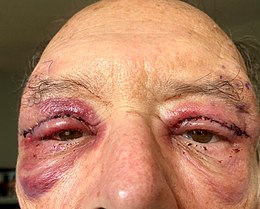This article needs more reliable medical references for verification or relies too heavily on primary sources. (December 2013) |  |
| Blepharoplasty | |
|---|---|
 Upper eyelid blepharoplasty: The blue-ink delineated surgical plan, and the incisions made to correct a defect of the patient′s upper eyelid. | |
| ICD-9-CM | 08 |
| MeSH | D019882 |
Blepharoplasty (Greek: blepharon, "eyelid" + plassein "to form") is the plastic surgery operation for correcting defects, deformities, and disfigurations of the eyelids; and for aesthetically modifying the eye region of the face. With the excision and the removal, or the repositioning (or both) of excess tissues, such as skin and adipocyte fat, and the reinforcement of the corresponding muscle and tendon tissues, the blepharoplasty procedure resolves functional and cosmetic problems of the periorbita, which is the area from the eyebrow to the upper portion of the cheek. The procedure is more common among women, who accounted for approximately 85% of blepharoplasty procedures in 2014 in the US and 88% of such procedures in the UK.[1][2]
The operative goals of a blepharoplastic procedure are the restoration of the correct functioning to the affected eyelid(s) and the restoration of the aesthetics of the eye-region of the face, which are achieved by eliminating excess skin from the eyelid(s), smoothing the underlying eye muscles, tightening the supporting structures, and resecting and re-draping the excess fat of the retroseptal area of the eye, in order to produce a smooth anatomic transition from the lower eyelid to the cheek.

In an eye surgery procedure, the usual correction or modification (or both) is of the upper and the lower eyelids, and of the surrounding tissues of the eyebrows, the upper nasal-bridge area, and the upper portions of the cheeks, which are achieved by modifying the periosteal coverings of the facial bones that form the orbit (eye socket). The periosteum comprises two-layer connective tissues that cover the bones of the human body:
- the external layer of networks of dense, connective tissues with blood vessels, and
- the internal, deep layer of collagenous bundles composed of spindle-shaped cells of connective tissue, and a network of thin, elastic fibres.
The East Asian blepharoplasty procedure differs from the classic blepharoplasty. In younger patients, the goal of the surgery is to create a supratarsal fold ("double eyelid surgery") whereas in older patients the goals are to create or elevate the supratarsal fold and to resect surplus eyelid skin ("Asian blepharoplasty").[3][4]
- ^ "2014 Plastic Surgery Statistics Report" (PDF). American Society of Plastic Surgeons. p. 12. Archived from the original (PDF) on 16 June 2015. Retrieved 31 March 2016.
- ^ Sedghi A (3 February 2014). "UK cosmetic surgery statistics 2013: which are the most popular?". The Guardian. Retrieved 31 March 2016.
- ^ Weng CJ (February 2009). "Oriental upper blepharoplasty". Seminars in Plastic Surgery. 23 (1): 5–15. doi:10.1055/s-0028-1110096. PMC 2884894. PMID 20567720.
- ^ McCurdy JA (February 2005). "Upper blepharoplasty in the Asian patient: the "double eyelid" operation". Facial Plastic Surgery Clinics of North America. 13 (1): 47–64. doi:10.1016/j.fsc.2004.07.001. PMID 15519927.